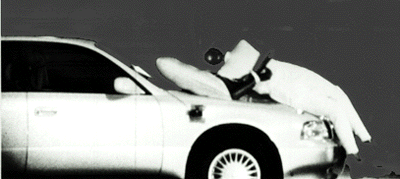
Japanese automobile manufacturers have all come out with prototypes of advanced safety vehicles that they are aiming to produce in the twenty-first century. Research and development is moving ahead with the encouragement of the Ministry of Transport, and the prototype models are equipped with automatic accident avoidance systems, devices to prevent drivers from dozing at the wheel, and other original concepts and state-of-the-art technologies. Demonstration runs will be made in Tokyo in March.
Priority on Safety
The project's goal is to develop advanced safety vehicles by employing electronics technology to elevate the vehicles' "intelligence." Four categories of safety features are being explored: preventive safety, accident avoidance, reducing damage on impact, and preventing damage from spreading after a collision. The manufacturers are placing priority on the first two categories in their competition to develop safer cars.
No-Doze Systems
The greatest diversity has appeared in systems to prevent drivers from falling asleep at the wheel. One employs sensors and a computer to analyze the driver's heartbeat and handling of the steering wheel. When telltale dozing signs are detected, an alarm sounds and the seat vibrates. If dozing continues, the car is stopped automatically.
Another manufacturer has adopted a method that detects dozing by observing the way the eyelids open and close. The driver's face is constantly registered by a small television camera. If the pattern of eyelid motion indicates the driver is falling asleep, a lemon or menthol fragrance with wake-up effects is released. If this proves ineffective, the car stops automatically. A third firm has focused on the weaving motion of a car driven by a dozing driver; when a sensor detects weaving, an alarm is sounded.
Radar Device to Prevent Collisions
To maintain proper distance between cars and avoid collisions, the prototype vehicles have been equipped with systems that include radar or TV cameras to detect cars, humans, and other obstacles around the vehicle and emit warnings when these are spotted. Among the systems designed to minimize damage on impact is one for accidents involving pedestrians in which an airbag on the hood of the car is ejected and inflates to soften the blow to the pedestrian's head. The imaginative technologies employed by each manufacturer also include systems that automatically reduce speed when rounding curves and corners and that automatically stop the car at intersections.
After the practicality of these technologies and their potential for mass production have been carefully assessed, they are gradually expected to be placed on the market.
(The above article, edited by Japan Echo Inc., is based on domestic Japanese news sources. It is offered for reference purposes and does not necessarily represent the policy or views of the Japanese Government.)